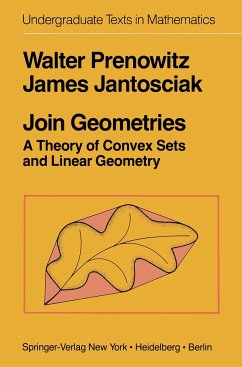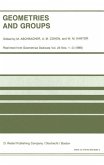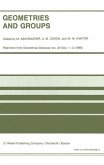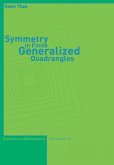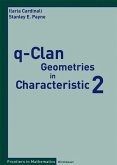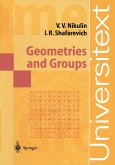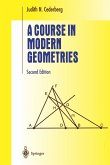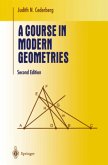- Broschiertes Buch
- Merkliste
- Auf die Merkliste
- Bewerten Bewerten
- Teilen
- Produkt teilen
- Produkterinnerung
- Produkterinnerung
The main object of this book is to reorient and revitalize classical geometry in a way that will bring it closer to the mainstream of contemporary mathematics. The postulational basis of the subject will be radically revised in order to construct a broad-scale and conceptually unified treatment. The familiar figures of classical geometry-points, segments, lines, planes, triangles, circles, and so on-stem from problems in the physical world and seem to be conceptually unrelated. However, a natural setting for their study is provided by the concept of convex set, which is compara tively new in…mehr
Andere Kunden interessierten sich auch für
![Geometries and Groups Geometries and Groups]() M. Aschbacher / A.M. Cohen / W.M. Kantor (Hgg.)Geometries and Groups153,99 €
M. Aschbacher / A.M. Cohen / W.M. Kantor (Hgg.)Geometries and Groups153,99 €![Geometries and Groups Geometries and Groups]() Geometries and Groups149,99 €
Geometries and Groups149,99 €![Symmetry in Finite Generalized Quadrangles Symmetry in Finite Generalized Quadrangles]() Koen ThasSymmetry in Finite Generalized Quadrangles43,99 €
Koen ThasSymmetry in Finite Generalized Quadrangles43,99 €![q-Clan Geometries in Characteristic 2 q-Clan Geometries in Characteristic 2]() Ilaria Cardinaliq-Clan Geometries in Characteristic 258,84 €
Ilaria Cardinaliq-Clan Geometries in Characteristic 258,84 €![Geometries and Groups Geometries and Groups]() Viacheslav V. NikulinGeometries and Groups56,99 €
Viacheslav V. NikulinGeometries and Groups56,99 €![A Course in Modern Geometries A Course in Modern Geometries]() Judith N. CederbergA Course in Modern Geometries56,99 €
Judith N. CederbergA Course in Modern Geometries56,99 €![A Course in Modern Geometries A Course in Modern Geometries]() Judith N. CederbergA Course in Modern Geometries45,99 €
Judith N. CederbergA Course in Modern Geometries45,99 €-
-
-
The main object of this book is to reorient and revitalize classical geometry in a way that will bring it closer to the mainstream of contemporary mathematics. The postulational basis of the subject will be radically revised in order to construct a broad-scale and conceptually unified treatment. The familiar figures of classical geometry-points, segments, lines, planes, triangles, circles, and so on-stem from problems in the physical world and seem to be conceptually unrelated. However, a natural setting for their study is provided by the concept of convex set, which is compara tively new in the history of geometrical ideas. The familiarfigures can then appear as convex sets, boundaries of convex sets, or finite unions of convex sets. Moreover, two basic types of figure in linear geometry are special cases of convex set: linear space (point, line, and plane) and halfspace (ray, halfplane, and halfspace). Therefore we choose convex set to be the central type of figure in our treatment of geometry. How can the wealth of geometric knowledge be organized around this idea? By defini tion, a set is convex if it contains the segment joining each pair of its points; that is, if it is closed under the operation of joining two points to form a segment. But this is precisely the basic operation in Euclid.
Hinweis: Dieser Artikel kann nur an eine deutsche Lieferadresse ausgeliefert werden.
Hinweis: Dieser Artikel kann nur an eine deutsche Lieferadresse ausgeliefert werden.
Produktdetails
- Produktdetails
- Undergraduate Texts in Mathematics
- Verlag: Springer / Springer New York / Springer, Berlin
- Artikelnr. des Verlages: 978-1-4613-9440-2
- Softcover reprint of the original 1st ed. 1979
- Seitenzahl: 560
- Erscheinungstermin: 9. Dezember 2011
- Englisch
- Abmessung: 235mm x 155mm x 30mm
- Gewicht: 838g
- ISBN-13: 9781461394402
- ISBN-10: 1461394406
- Artikelnr.: 39495292
- Herstellerkennzeichnung
- Springer-Verlag GmbH
- Tiergartenstr. 17
- 69121 Heidelberg
- ProductSafety@springernature.com
- Undergraduate Texts in Mathematics
- Verlag: Springer / Springer New York / Springer, Berlin
- Artikelnr. des Verlages: 978-1-4613-9440-2
- Softcover reprint of the original 1st ed. 1979
- Seitenzahl: 560
- Erscheinungstermin: 9. Dezember 2011
- Englisch
- Abmessung: 235mm x 155mm x 30mm
- Gewicht: 838g
- ISBN-13: 9781461394402
- ISBN-10: 1461394406
- Artikelnr.: 39495292
- Herstellerkennzeichnung
- Springer-Verlag GmbH
- Tiergartenstr. 17
- 69121 Heidelberg
- ProductSafety@springernature.com
1 The Join and Extension Operations in Euclidean Geometry.
1.1 The Notion of Segment: Closed and Open.
1.2 The Join of Two Distinct Points.
1.3 Two Basic Properties of the Join Operation.
1.4 A Crucial Question.
1.5 The Join of Two Geometric Figures.
1.6 Joins of Several Points: Does the Associative Law Hold?.
1.7 The Join of Two Intersecting Geometric Figures.
1.8 A Decision Must Be Made.
1.9 The Join of a Point and Itself.
1.10 The Unrestricted Applicability of the Join Operation.
1.11 The Unrestricted Validity of the Associative Law for Join.
1.12 The Universality of the Associative Law.
1.13 Alternatives to the Definition aa = a.
1.14 Convex Sets.
1.15 A Geometric Proof in Join Terminology.
1.16 A New Operation: The Idea of Extension.
1.17 The Notion of Halfline or Ray.
1.18 Formal Definition of the Extension Operation.
1.19 Identification of Extension as a Geometrical Figure.
1.20 Properties of the Extension Operation.
1.21 The Extension of Two Geometric Figures.
1.22 The Generation of Unbounded or Endless Figures.
1.23 Is There an Alternative to Join as Open Segment?.
2 The Abstract Theory of Join Operations.
2.1 The Join Operation in Euclidean Geometry.
2.2 Join Operations in a Set
Join Systems.
2.3 The Postulates for the Operation Join.
2.4 Application of the Theory to Euclidean Geometry.
2.5 Elementary Properties of Join.
2.6 Generalizations of J1
J4 to Sets.
2.7 Extension of the Join Operation to n Terms.
2.8 Comparison with the Conventional View of Geometry.
2.9 Convex Sets.
2.10 Joins, Intersections and Unions of Convex Sets.
2.11 Interiors and Frontiers of Convex Sets.
2.12 Euclidean Interiors and Frontiers.
2.13 Interiority Properties of Convex Sets.
2.14 Absorption by Joining.
2.15 Closures of Euclidean Convex Sets, Intuitively Treated.
2.16 The Closure of a Convex Set.
2.17 Closure Properties of Convex Sets.
2.18 Composition of the Interior and Closure Functions.
2.19 The Boundary of a Convex Set.
2.20 Project: Another Formulation of the Theory of Join.
2.21 What Does the Theory Apply To?.
2.22 The Triode Model.
2.23 A Peculiarity of the Triode Model.
2.24 The Cartesian Join Model.
2.25 The Metric Interior of a Set in Euclidean Geometry.
2.26 The Metric Closure of a Set in Euclidean Geometry.
3 The Generation of Convex Sets
Convex Hulls.
3.1 Introduction to Convexification: Two Euclidean Examples.
3.2 Convexification of an Arbitrary Set.
3.3 Finitely Generated Convex Sets
the Concept of Polytope.
3.4 A Formula for a Polytope.
3.5 A Distributive Law.
3.6 An Absorption Property of Polytopes.
3.7 Interiors and Closures of Polytopes.
3.8 Powers of a Set and Polytopes.
3.9 The Representation of Convex Hulls.
3.10 Convex Hulls and Powers of a Set.
3.11 Bounded Sets.
3.12 Project
the Closed Join Operation.
3.13 Convex Hulls of Finite Families of Sets
Generalized Polytopes.
3.14 Properties of Generalized Polytopes.
3.15 Examples of Generalized Polytopes.
4 The Operation of Extension.
4.1 Definition of the Extension Operation.
4.2 The Extension Operation for Sets.
4.3 The Monotonic Law for Extension.
4.4 Distributive Laws for Extension.
4.5 The Relation "Intersects" or "Meets".
4.6 The Three Term Transposition Law.
4.7 The Mixed Associative Law.
4.8 Three New Postulates.
4.9 Discussion of the Postulates.
4.10 Formal Consequences of the Postulate Set J1
J7.
4.11 Formal Consequences Continued.
4.12 Joins and Extensions of Rays.
4.13 Solving Problems.
4.14 Extreme Points of Convex Sets.
4.15 Open Convex Sets.
4.16 The Intersection of Open Sets.
4.17 The Join of Open Sets.
4.18 Segments Are Infinite.
4.19 The Polytope Interior Theorem.
4.20 The Interior of a Join of Convex Sets.
4.21 The Generalized Polytope Interior Theorem.
4.22 Closed Convex Sets.
4.23 The Theory of Order.
4.24 Ordered Sets of Points.
4.25 Separation of Points by a Point.
4.26 Perspectivity and Precedence of Points.
5 Join Geometries.
5.1 The Concept of a Join Geometry.
5.2 A List of Join Geometries.
5.3 Deducibility and Counterexamples.
5.4 The Existence of Points.
5.5 Isomorphism of Join Systems.
5.6 A Class of Join Geometries of Arbitrary Dimension.
5.7 ?n Is Converted into a Vector Space.
5.8 Restatement of the Definition of Join in ?n.
5.9 Proof That (?n, ·) Is a Join Geometry.
5.10 Linear Inequalities and Halfspaces.
5.11 Pathological Convex Sets.
5.12 An Infinite Dimensional Join Geometry.
5.13 Three Pathological Convex Sets.
5.14 Is There a Simple Way to Construct Pathological Convex Sets?.
6 Linear Sets.
6.1 The Notion of Linear Set.
6.2 The Definition of Linear Set.
6.3 Conditions for Linearity.
6.4 Constructing Linear Sets from Linear Sets.
6.5 The Construction of a Linear Set from a Convex Set.
6.6 Linear Sets Give Rise to Join Geometries.
6.7 The Generation of Linear Sets: Two Euclidean Examples.
6.8 The Generation of Linear Sets: General Case.
6.9 The Linear Hull of a Finite Set: Finitely Generated Linear Sets.
6.10 The Definition of Line.
6.11 The Linear Hull of an Arbitrary Set.
6.12 The Linear Hull of a Finite Family of Sets.
6.13 Linear Hulls of Interiors and Closures.
6.14 Geometric Relations of Points
Linear Dependence and Independence.
6.15 Properties of Linearly Independent Points.
6.16 Simplexes.
6.17 Linear Dependence and Intersection of Joins.
6.18 Covering in the Family of Linear Sets
Hyperplanes.
6.19 The Height of a Linear Set
Approach to a Theory of Dimension.
6.20 Linear Sets and the Interior Operation.
6.21 Applications: Interiority Properties.
6.22 The Prevalence of Nonpathological Convex Sets.
6.23 The Linear Hull of a Pair of Convex Sets.
6.24 The Interior of the Extension of Two Convex Sets.
7 Extremal Structure of Convex Sets: Components and Faces.
7.1 The Notion of an Extreme Set of a Convex Set.
7.2 The Definition of Extreme Set of a Convex Set.
7.3 Remarks on the Definition.
7.4 Elementary Properties of Extreme Sets.
7.5 The Interior Operation Is Applied to Extreme Sets.
7.6 The Closure Operation Is Applied to Extreme Sets.
7.7 Other Characterizations of Extremeness.
7.8 Is Extremeness Preserved under Join and Extension?.
7.9 Extreme Sets with a Preassigned Interior Point.
7.10 Classifying Extreme Sets.
7.11 Open Extreme Sets: Components.
7.12 The Partition Theorem for Convex Sets.
7.13 The Component Structure of a Convex Set.
7.14 Components as Maximal Open Subsets.
7.15 Intersection Properties of Components.
7.16 Components and Perspectivity of Points.
7.17 Components of Polytopes.
7.18 The Concept of a Face of a Convex Set.
7.19 The Nonseparation Property of a Face.
7.20 Elementary Properties of Faces of Convex Sets.
7.21 Additional Properties of Faces.
7.22 Facial Structure of Convex Sets.
7.23 Facial Structure Continued.
7.24 A Correspondence Between Components and Faces.
7.25 Faces of Polytopes.
7.26 Covering in the Family of Faces of a Convex Set.
7.27 Extreme Sets and Extremal Linear Spaces.
7.28 Associated Extreme Sets.
7.29 Covering of Extremals Arising from Faces.
7.30 Extremal Hyperplanes and Exposed Faces.
7.31 Supporting and Tangent Hyperplanes.
8 Rays and Halfspaces.
8.1 Elementary Properties of Rays.
8.2 Elementary Operations on Rays.
8.3 Opposite Rays.
8.4 Separation of Two Rays by a Common Endpoint.
8.5 The Partition of Space into Rays.
8.6 Closed Rays.
8.7 The Linear Hull of a Ray.
8.8 The Halfspaces of a Linear Set.
8.9 A Point of Terminology.
8.10 Elementary Properties of L
Rays.
8.11 Elementary Operations on L
Rays.
8.12 Opposite Halfspaces.
8.13 Separation of Two Halfspaces by a Common Edge.
8.14 The Partition of Space into Halfspaces.
8.15 Closed Halfspaces.
8.16 The Linear Hull of a Halfspace.
9 Cones and Hypercones.
9.1 Cones.
9.2 Convex Cones.
9.3 Pointed Convex Cones.
9.4 Generation of Convex Cones.
9.5 How Shall Convex o
Cones Be Generated?.
9.6 Polyhedral Cones.
9.7 Finiteness of Generation of Convex Cones.
9.8 Extreme Rays.
9.9 Extreme Rays of Convex Cones.
9.10 The Analogous Development Breaks Down.
9.11 Regularly Imbedded Rays.
9.12 The Generation of Convex Cones by Extreme Rays.
9.13 Hypercones.
9.14 Elementary Properties of Hypercones.
9.15 Convex Hypercones.
9.16 Tapered Convex Hypercones.
9.17 Generation of Convex Hypercones.
9.18 Polyhedral Hypercones.
9.19 Finiteness of Generation of Convex Hypercones.
9.20 Extreme Halfspaces of Convex Hypercones.
9.21 Regularly Imbedded Half spaces.
9.22 The Generation of Convex Hypercones by Extreme Half spaces.
10 Factor Geometries and Congruence Relations.
10.1 Congruence Relations Determined by Halfspaces.
10.2 Pairs of Congruences.
10.3 Congruence Relations between Sets.
10.4 Properties of Modular Set Congruence.
10.5 Families of Halfspaces.
10.6 New Notations.
10.7 A Join Operation in J : M.
10.8 Factor Geometries.
10.9 J: M Satisfies J1
J6.
10.10 Geometric Interpretation of Factor Geometries.
10.11 Continuation of the Theory of Factor Geometries.
10.12 Differences Between J : M and J.
10.13 A Correspondence Relating J : M and J.
10.14 Convexity in a Factor Geometry.
10.15 Linearity in a Factor Geometry.
10.16 The Cross Section Correspondence.
10.17 Isomorphism of Factor Geometries.
11 Exchange Join Geometries
The Theory of Incidence and Dimension.
11.1 Exchange Join Geometries.
11.2 Two Points Determine a Line.
11.3 A Basis for a Linear Space.
11.4 Incidence Properties.
11.5 The Exchange Theorem.
11.6 Rank and Dimension.
11.7 Rank and Linear Containment.
11.8 Rank and Covering.
11.9 The Dimension Principle.
11.10 Characterizations of Linear Dependence.
11.11 Rank of a Set of Points.
11.12 Rank and Height of Linear Spaces.
12 Ordered Join Geometries.
12.1 Ordered Join Geometries.
12.2 Two Points Determine a Line.
12.3 A New Formula for Line ab.
12.4 A Formula for a Ray.
12.5 Another Formula for a Line.
12.6 An Expansion Formula for a Segment.
12.7 An Expansion Formula for a Join of Points.
12.8 An Expansion for a Polytope.
12.9 Modularity Principles.
12.10 The Section of a Polytope by a Linear Space.
12.11 Consequences of the Polytope Section Theorem.
12.12 Polytopes Are Closed.
12.13 The Interior of a Polytope
Another View.
12.14 Separation Property of the Frontier of a Polytope.
12.15 A New Formula for Linear Hulls.
12.16 Convex Dependence and Independence.
12.17 How Are C
Dependence and L
Dependence Related?.
12.18 Convex Dependence and Independence in an Ordered Geometry.
12.19 Convex Dependence and Polytopes.
12.20 Helly's Theorem.
12.21 Decomposition of Polytopes into Subpolytopes: Caratheodory's Theorem.
12.22 Equivalence of Linear and Convex Independence.
12.23 The Separation of Linear Spaces by Linear Spaces.
13 The Structure of Polytopes in an Ordered Geometry.
13.1 Enclosing Convex Sets in Closed Halfspaces.
13.2 Interpreting the Results.
13.3 Supporting Halfspaces to Convex Sets.
13.4 Supporting Hyperplanes to Polytopes Exist.
13.5 Polytopes Are Intersections of Closed Half spaces.
13.6 Covering of Faces of a Polytope and Their Linear Hulls.
13.7 Facets of a Polytope.
13.8 Facial Structure of a Polytope.
13.9 Facets of a Facet of a Polytope.
13.10 Generation of Convex Sets by Extreme Points.
13.11 Terminal Segments and Dispensability of Generating Points.
13.12 Dispensability Sequences.
13.13 Generation Conditions.
13.14 Segmental Closure and Linear Boundedness.
13.15 Convex Sets Generated by Their Extreme Points.
13.16 A Characterization of a Polytope.
13.17 Polytopes and Intersections of Closed Halfspaces.
References.
1.1 The Notion of Segment: Closed and Open.
1.2 The Join of Two Distinct Points.
1.3 Two Basic Properties of the Join Operation.
1.4 A Crucial Question.
1.5 The Join of Two Geometric Figures.
1.6 Joins of Several Points: Does the Associative Law Hold?.
1.7 The Join of Two Intersecting Geometric Figures.
1.8 A Decision Must Be Made.
1.9 The Join of a Point and Itself.
1.10 The Unrestricted Applicability of the Join Operation.
1.11 The Unrestricted Validity of the Associative Law for Join.
1.12 The Universality of the Associative Law.
1.13 Alternatives to the Definition aa = a.
1.14 Convex Sets.
1.15 A Geometric Proof in Join Terminology.
1.16 A New Operation: The Idea of Extension.
1.17 The Notion of Halfline or Ray.
1.18 Formal Definition of the Extension Operation.
1.19 Identification of Extension as a Geometrical Figure.
1.20 Properties of the Extension Operation.
1.21 The Extension of Two Geometric Figures.
1.22 The Generation of Unbounded or Endless Figures.
1.23 Is There an Alternative to Join as Open Segment?.
2 The Abstract Theory of Join Operations.
2.1 The Join Operation in Euclidean Geometry.
2.2 Join Operations in a Set
Join Systems.
2.3 The Postulates for the Operation Join.
2.4 Application of the Theory to Euclidean Geometry.
2.5 Elementary Properties of Join.
2.6 Generalizations of J1
J4 to Sets.
2.7 Extension of the Join Operation to n Terms.
2.8 Comparison with the Conventional View of Geometry.
2.9 Convex Sets.
2.10 Joins, Intersections and Unions of Convex Sets.
2.11 Interiors and Frontiers of Convex Sets.
2.12 Euclidean Interiors and Frontiers.
2.13 Interiority Properties of Convex Sets.
2.14 Absorption by Joining.
2.15 Closures of Euclidean Convex Sets, Intuitively Treated.
2.16 The Closure of a Convex Set.
2.17 Closure Properties of Convex Sets.
2.18 Composition of the Interior and Closure Functions.
2.19 The Boundary of a Convex Set.
2.20 Project: Another Formulation of the Theory of Join.
2.21 What Does the Theory Apply To?.
2.22 The Triode Model.
2.23 A Peculiarity of the Triode Model.
2.24 The Cartesian Join Model.
2.25 The Metric Interior of a Set in Euclidean Geometry.
2.26 The Metric Closure of a Set in Euclidean Geometry.
3 The Generation of Convex Sets
Convex Hulls.
3.1 Introduction to Convexification: Two Euclidean Examples.
3.2 Convexification of an Arbitrary Set.
3.3 Finitely Generated Convex Sets
the Concept of Polytope.
3.4 A Formula for a Polytope.
3.5 A Distributive Law.
3.6 An Absorption Property of Polytopes.
3.7 Interiors and Closures of Polytopes.
3.8 Powers of a Set and Polytopes.
3.9 The Representation of Convex Hulls.
3.10 Convex Hulls and Powers of a Set.
3.11 Bounded Sets.
3.12 Project
the Closed Join Operation.
3.13 Convex Hulls of Finite Families of Sets
Generalized Polytopes.
3.14 Properties of Generalized Polytopes.
3.15 Examples of Generalized Polytopes.
4 The Operation of Extension.
4.1 Definition of the Extension Operation.
4.2 The Extension Operation for Sets.
4.3 The Monotonic Law for Extension.
4.4 Distributive Laws for Extension.
4.5 The Relation "Intersects" or "Meets".
4.6 The Three Term Transposition Law.
4.7 The Mixed Associative Law.
4.8 Three New Postulates.
4.9 Discussion of the Postulates.
4.10 Formal Consequences of the Postulate Set J1
J7.
4.11 Formal Consequences Continued.
4.12 Joins and Extensions of Rays.
4.13 Solving Problems.
4.14 Extreme Points of Convex Sets.
4.15 Open Convex Sets.
4.16 The Intersection of Open Sets.
4.17 The Join of Open Sets.
4.18 Segments Are Infinite.
4.19 The Polytope Interior Theorem.
4.20 The Interior of a Join of Convex Sets.
4.21 The Generalized Polytope Interior Theorem.
4.22 Closed Convex Sets.
4.23 The Theory of Order.
4.24 Ordered Sets of Points.
4.25 Separation of Points by a Point.
4.26 Perspectivity and Precedence of Points.
5 Join Geometries.
5.1 The Concept of a Join Geometry.
5.2 A List of Join Geometries.
5.3 Deducibility and Counterexamples.
5.4 The Existence of Points.
5.5 Isomorphism of Join Systems.
5.6 A Class of Join Geometries of Arbitrary Dimension.
5.7 ?n Is Converted into a Vector Space.
5.8 Restatement of the Definition of Join in ?n.
5.9 Proof That (?n, ·) Is a Join Geometry.
5.10 Linear Inequalities and Halfspaces.
5.11 Pathological Convex Sets.
5.12 An Infinite Dimensional Join Geometry.
5.13 Three Pathological Convex Sets.
5.14 Is There a Simple Way to Construct Pathological Convex Sets?.
6 Linear Sets.
6.1 The Notion of Linear Set.
6.2 The Definition of Linear Set.
6.3 Conditions for Linearity.
6.4 Constructing Linear Sets from Linear Sets.
6.5 The Construction of a Linear Set from a Convex Set.
6.6 Linear Sets Give Rise to Join Geometries.
6.7 The Generation of Linear Sets: Two Euclidean Examples.
6.8 The Generation of Linear Sets: General Case.
6.9 The Linear Hull of a Finite Set: Finitely Generated Linear Sets.
6.10 The Definition of Line.
6.11 The Linear Hull of an Arbitrary Set.
6.12 The Linear Hull of a Finite Family of Sets.
6.13 Linear Hulls of Interiors and Closures.
6.14 Geometric Relations of Points
Linear Dependence and Independence.
6.15 Properties of Linearly Independent Points.
6.16 Simplexes.
6.17 Linear Dependence and Intersection of Joins.
6.18 Covering in the Family of Linear Sets
Hyperplanes.
6.19 The Height of a Linear Set
Approach to a Theory of Dimension.
6.20 Linear Sets and the Interior Operation.
6.21 Applications: Interiority Properties.
6.22 The Prevalence of Nonpathological Convex Sets.
6.23 The Linear Hull of a Pair of Convex Sets.
6.24 The Interior of the Extension of Two Convex Sets.
7 Extremal Structure of Convex Sets: Components and Faces.
7.1 The Notion of an Extreme Set of a Convex Set.
7.2 The Definition of Extreme Set of a Convex Set.
7.3 Remarks on the Definition.
7.4 Elementary Properties of Extreme Sets.
7.5 The Interior Operation Is Applied to Extreme Sets.
7.6 The Closure Operation Is Applied to Extreme Sets.
7.7 Other Characterizations of Extremeness.
7.8 Is Extremeness Preserved under Join and Extension?.
7.9 Extreme Sets with a Preassigned Interior Point.
7.10 Classifying Extreme Sets.
7.11 Open Extreme Sets: Components.
7.12 The Partition Theorem for Convex Sets.
7.13 The Component Structure of a Convex Set.
7.14 Components as Maximal Open Subsets.
7.15 Intersection Properties of Components.
7.16 Components and Perspectivity of Points.
7.17 Components of Polytopes.
7.18 The Concept of a Face of a Convex Set.
7.19 The Nonseparation Property of a Face.
7.20 Elementary Properties of Faces of Convex Sets.
7.21 Additional Properties of Faces.
7.22 Facial Structure of Convex Sets.
7.23 Facial Structure Continued.
7.24 A Correspondence Between Components and Faces.
7.25 Faces of Polytopes.
7.26 Covering in the Family of Faces of a Convex Set.
7.27 Extreme Sets and Extremal Linear Spaces.
7.28 Associated Extreme Sets.
7.29 Covering of Extremals Arising from Faces.
7.30 Extremal Hyperplanes and Exposed Faces.
7.31 Supporting and Tangent Hyperplanes.
8 Rays and Halfspaces.
8.1 Elementary Properties of Rays.
8.2 Elementary Operations on Rays.
8.3 Opposite Rays.
8.4 Separation of Two Rays by a Common Endpoint.
8.5 The Partition of Space into Rays.
8.6 Closed Rays.
8.7 The Linear Hull of a Ray.
8.8 The Halfspaces of a Linear Set.
8.9 A Point of Terminology.
8.10 Elementary Properties of L
Rays.
8.11 Elementary Operations on L
Rays.
8.12 Opposite Halfspaces.
8.13 Separation of Two Halfspaces by a Common Edge.
8.14 The Partition of Space into Halfspaces.
8.15 Closed Halfspaces.
8.16 The Linear Hull of a Halfspace.
9 Cones and Hypercones.
9.1 Cones.
9.2 Convex Cones.
9.3 Pointed Convex Cones.
9.4 Generation of Convex Cones.
9.5 How Shall Convex o
Cones Be Generated?.
9.6 Polyhedral Cones.
9.7 Finiteness of Generation of Convex Cones.
9.8 Extreme Rays.
9.9 Extreme Rays of Convex Cones.
9.10 The Analogous Development Breaks Down.
9.11 Regularly Imbedded Rays.
9.12 The Generation of Convex Cones by Extreme Rays.
9.13 Hypercones.
9.14 Elementary Properties of Hypercones.
9.15 Convex Hypercones.
9.16 Tapered Convex Hypercones.
9.17 Generation of Convex Hypercones.
9.18 Polyhedral Hypercones.
9.19 Finiteness of Generation of Convex Hypercones.
9.20 Extreme Halfspaces of Convex Hypercones.
9.21 Regularly Imbedded Half spaces.
9.22 The Generation of Convex Hypercones by Extreme Half spaces.
10 Factor Geometries and Congruence Relations.
10.1 Congruence Relations Determined by Halfspaces.
10.2 Pairs of Congruences.
10.3 Congruence Relations between Sets.
10.4 Properties of Modular Set Congruence.
10.5 Families of Halfspaces.
10.6 New Notations.
10.7 A Join Operation in J : M.
10.8 Factor Geometries.
10.9 J: M Satisfies J1
J6.
10.10 Geometric Interpretation of Factor Geometries.
10.11 Continuation of the Theory of Factor Geometries.
10.12 Differences Between J : M and J.
10.13 A Correspondence Relating J : M and J.
10.14 Convexity in a Factor Geometry.
10.15 Linearity in a Factor Geometry.
10.16 The Cross Section Correspondence.
10.17 Isomorphism of Factor Geometries.
11 Exchange Join Geometries
The Theory of Incidence and Dimension.
11.1 Exchange Join Geometries.
11.2 Two Points Determine a Line.
11.3 A Basis for a Linear Space.
11.4 Incidence Properties.
11.5 The Exchange Theorem.
11.6 Rank and Dimension.
11.7 Rank and Linear Containment.
11.8 Rank and Covering.
11.9 The Dimension Principle.
11.10 Characterizations of Linear Dependence.
11.11 Rank of a Set of Points.
11.12 Rank and Height of Linear Spaces.
12 Ordered Join Geometries.
12.1 Ordered Join Geometries.
12.2 Two Points Determine a Line.
12.3 A New Formula for Line ab.
12.4 A Formula for a Ray.
12.5 Another Formula for a Line.
12.6 An Expansion Formula for a Segment.
12.7 An Expansion Formula for a Join of Points.
12.8 An Expansion for a Polytope.
12.9 Modularity Principles.
12.10 The Section of a Polytope by a Linear Space.
12.11 Consequences of the Polytope Section Theorem.
12.12 Polytopes Are Closed.
12.13 The Interior of a Polytope
Another View.
12.14 Separation Property of the Frontier of a Polytope.
12.15 A New Formula for Linear Hulls.
12.16 Convex Dependence and Independence.
12.17 How Are C
Dependence and L
Dependence Related?.
12.18 Convex Dependence and Independence in an Ordered Geometry.
12.19 Convex Dependence and Polytopes.
12.20 Helly's Theorem.
12.21 Decomposition of Polytopes into Subpolytopes: Caratheodory's Theorem.
12.22 Equivalence of Linear and Convex Independence.
12.23 The Separation of Linear Spaces by Linear Spaces.
13 The Structure of Polytopes in an Ordered Geometry.
13.1 Enclosing Convex Sets in Closed Halfspaces.
13.2 Interpreting the Results.
13.3 Supporting Halfspaces to Convex Sets.
13.4 Supporting Hyperplanes to Polytopes Exist.
13.5 Polytopes Are Intersections of Closed Half spaces.
13.6 Covering of Faces of a Polytope and Their Linear Hulls.
13.7 Facets of a Polytope.
13.8 Facial Structure of a Polytope.
13.9 Facets of a Facet of a Polytope.
13.10 Generation of Convex Sets by Extreme Points.
13.11 Terminal Segments and Dispensability of Generating Points.
13.12 Dispensability Sequences.
13.13 Generation Conditions.
13.14 Segmental Closure and Linear Boundedness.
13.15 Convex Sets Generated by Their Extreme Points.
13.16 A Characterization of a Polytope.
13.17 Polytopes and Intersections of Closed Halfspaces.
References.
1 The Join and Extension Operations in Euclidean Geometry.- 2 The Abstract Theory of Join Operations.- 3 The Generation of Convex Sets-Convex Hulls.- 4 The Operation of Extension.- 5 Join Geometries.- 6 Linear Sets.- 7 Extremal Structure of Convex Sets: Components and Faces.- 8 Rays and Halfspaces.- 9 Cones and Hypercones.- 10 Factor Geometries and Congruence Relations.- 11 Exchange Join Geometries-The Theory of Incidence and Dimension.- 12 Ordered Join Geometries.- 13 The Structure of Polytopes in an Ordered Geometry.- References.
1 The Join and Extension Operations in Euclidean Geometry.
1.1 The Notion of Segment: Closed and Open.
1.2 The Join of Two Distinct Points.
1.3 Two Basic Properties of the Join Operation.
1.4 A Crucial Question.
1.5 The Join of Two Geometric Figures.
1.6 Joins of Several Points: Does the Associative Law Hold?.
1.7 The Join of Two Intersecting Geometric Figures.
1.8 A Decision Must Be Made.
1.9 The Join of a Point and Itself.
1.10 The Unrestricted Applicability of the Join Operation.
1.11 The Unrestricted Validity of the Associative Law for Join.
1.12 The Universality of the Associative Law.
1.13 Alternatives to the Definition aa = a.
1.14 Convex Sets.
1.15 A Geometric Proof in Join Terminology.
1.16 A New Operation: The Idea of Extension.
1.17 The Notion of Halfline or Ray.
1.18 Formal Definition of the Extension Operation.
1.19 Identification of Extension as a Geometrical Figure.
1.20 Properties of the Extension Operation.
1.21 The Extension of Two Geometric Figures.
1.22 The Generation of Unbounded or Endless Figures.
1.23 Is There an Alternative to Join as Open Segment?.
2 The Abstract Theory of Join Operations.
2.1 The Join Operation in Euclidean Geometry.
2.2 Join Operations in a Set
Join Systems.
2.3 The Postulates for the Operation Join.
2.4 Application of the Theory to Euclidean Geometry.
2.5 Elementary Properties of Join.
2.6 Generalizations of J1
J4 to Sets.
2.7 Extension of the Join Operation to n Terms.
2.8 Comparison with the Conventional View of Geometry.
2.9 Convex Sets.
2.10 Joins, Intersections and Unions of Convex Sets.
2.11 Interiors and Frontiers of Convex Sets.
2.12 Euclidean Interiors and Frontiers.
2.13 Interiority Properties of Convex Sets.
2.14 Absorption by Joining.
2.15 Closures of Euclidean Convex Sets, Intuitively Treated.
2.16 The Closure of a Convex Set.
2.17 Closure Properties of Convex Sets.
2.18 Composition of the Interior and Closure Functions.
2.19 The Boundary of a Convex Set.
2.20 Project: Another Formulation of the Theory of Join.
2.21 What Does the Theory Apply To?.
2.22 The Triode Model.
2.23 A Peculiarity of the Triode Model.
2.24 The Cartesian Join Model.
2.25 The Metric Interior of a Set in Euclidean Geometry.
2.26 The Metric Closure of a Set in Euclidean Geometry.
3 The Generation of Convex Sets
Convex Hulls.
3.1 Introduction to Convexification: Two Euclidean Examples.
3.2 Convexification of an Arbitrary Set.
3.3 Finitely Generated Convex Sets
the Concept of Polytope.
3.4 A Formula for a Polytope.
3.5 A Distributive Law.
3.6 An Absorption Property of Polytopes.
3.7 Interiors and Closures of Polytopes.
3.8 Powers of a Set and Polytopes.
3.9 The Representation of Convex Hulls.
3.10 Convex Hulls and Powers of a Set.
3.11 Bounded Sets.
3.12 Project
the Closed Join Operation.
3.13 Convex Hulls of Finite Families of Sets
Generalized Polytopes.
3.14 Properties of Generalized Polytopes.
3.15 Examples of Generalized Polytopes.
4 The Operation of Extension.
4.1 Definition of the Extension Operation.
4.2 The Extension Operation for Sets.
4.3 The Monotonic Law for Extension.
4.4 Distributive Laws for Extension.
4.5 The Relation "Intersects" or "Meets".
4.6 The Three Term Transposition Law.
4.7 The Mixed Associative Law.
4.8 Three New Postulates.
4.9 Discussion of the Postulates.
4.10 Formal Consequences of the Postulate Set J1
J7.
4.11 Formal Consequences Continued.
4.12 Joins and Extensions of Rays.
4.13 Solving Problems.
4.14 Extreme Points of Convex Sets.
4.15 Open Convex Sets.
4.16 The Intersection of Open Sets.
4.17 The Join of Open Sets.
4.18 Segments Are Infinite.
4.19 The Polytope Interior Theorem.
4.20 The Interior of a Join of Convex Sets.
4.21 The Generalized Polytope Interior Theorem.
4.22 Closed Convex Sets.
4.23 The Theory of Order.
4.24 Ordered Sets of Points.
4.25 Separation of Points by a Point.
4.26 Perspectivity and Precedence of Points.
5 Join Geometries.
5.1 The Concept of a Join Geometry.
5.2 A List of Join Geometries.
5.3 Deducibility and Counterexamples.
5.4 The Existence of Points.
5.5 Isomorphism of Join Systems.
5.6 A Class of Join Geometries of Arbitrary Dimension.
5.7 ?n Is Converted into a Vector Space.
5.8 Restatement of the Definition of Join in ?n.
5.9 Proof That (?n, ·) Is a Join Geometry.
5.10 Linear Inequalities and Halfspaces.
5.11 Pathological Convex Sets.
5.12 An Infinite Dimensional Join Geometry.
5.13 Three Pathological Convex Sets.
5.14 Is There a Simple Way to Construct Pathological Convex Sets?.
6 Linear Sets.
6.1 The Notion of Linear Set.
6.2 The Definition of Linear Set.
6.3 Conditions for Linearity.
6.4 Constructing Linear Sets from Linear Sets.
6.5 The Construction of a Linear Set from a Convex Set.
6.6 Linear Sets Give Rise to Join Geometries.
6.7 The Generation of Linear Sets: Two Euclidean Examples.
6.8 The Generation of Linear Sets: General Case.
6.9 The Linear Hull of a Finite Set: Finitely Generated Linear Sets.
6.10 The Definition of Line.
6.11 The Linear Hull of an Arbitrary Set.
6.12 The Linear Hull of a Finite Family of Sets.
6.13 Linear Hulls of Interiors and Closures.
6.14 Geometric Relations of Points
Linear Dependence and Independence.
6.15 Properties of Linearly Independent Points.
6.16 Simplexes.
6.17 Linear Dependence and Intersection of Joins.
6.18 Covering in the Family of Linear Sets
Hyperplanes.
6.19 The Height of a Linear Set
Approach to a Theory of Dimension.
6.20 Linear Sets and the Interior Operation.
6.21 Applications: Interiority Properties.
6.22 The Prevalence of Nonpathological Convex Sets.
6.23 The Linear Hull of a Pair of Convex Sets.
6.24 The Interior of the Extension of Two Convex Sets.
7 Extremal Structure of Convex Sets: Components and Faces.
7.1 The Notion of an Extreme Set of a Convex Set.
7.2 The Definition of Extreme Set of a Convex Set.
7.3 Remarks on the Definition.
7.4 Elementary Properties of Extreme Sets.
7.5 The Interior Operation Is Applied to Extreme Sets.
7.6 The Closure Operation Is Applied to Extreme Sets.
7.7 Other Characterizations of Extremeness.
7.8 Is Extremeness Preserved under Join and Extension?.
7.9 Extreme Sets with a Preassigned Interior Point.
7.10 Classifying Extreme Sets.
7.11 Open Extreme Sets: Components.
7.12 The Partition Theorem for Convex Sets.
7.13 The Component Structure of a Convex Set.
7.14 Components as Maximal Open Subsets.
7.15 Intersection Properties of Components.
7.16 Components and Perspectivity of Points.
7.17 Components of Polytopes.
7.18 The Concept of a Face of a Convex Set.
7.19 The Nonseparation Property of a Face.
7.20 Elementary Properties of Faces of Convex Sets.
7.21 Additional Properties of Faces.
7.22 Facial Structure of Convex Sets.
7.23 Facial Structure Continued.
7.24 A Correspondence Between Components and Faces.
7.25 Faces of Polytopes.
7.26 Covering in the Family of Faces of a Convex Set.
7.27 Extreme Sets and Extremal Linear Spaces.
7.28 Associated Extreme Sets.
7.29 Covering of Extremals Arising from Faces.
7.30 Extremal Hyperplanes and Exposed Faces.
7.31 Supporting and Tangent Hyperplanes.
8 Rays and Halfspaces.
8.1 Elementary Properties of Rays.
8.2 Elementary Operations on Rays.
8.3 Opposite Rays.
8.4 Separation of Two Rays by a Common Endpoint.
8.5 The Partition of Space into Rays.
8.6 Closed Rays.
8.7 The Linear Hull of a Ray.
8.8 The Halfspaces of a Linear Set.
8.9 A Point of Terminology.
8.10 Elementary Properties of L
Rays.
8.11 Elementary Operations on L
Rays.
8.12 Opposite Halfspaces.
8.13 Separation of Two Halfspaces by a Common Edge.
8.14 The Partition of Space into Halfspaces.
8.15 Closed Halfspaces.
8.16 The Linear Hull of a Halfspace.
9 Cones and Hypercones.
9.1 Cones.
9.2 Convex Cones.
9.3 Pointed Convex Cones.
9.4 Generation of Convex Cones.
9.5 How Shall Convex o
Cones Be Generated?.
9.6 Polyhedral Cones.
9.7 Finiteness of Generation of Convex Cones.
9.8 Extreme Rays.
9.9 Extreme Rays of Convex Cones.
9.10 The Analogous Development Breaks Down.
9.11 Regularly Imbedded Rays.
9.12 The Generation of Convex Cones by Extreme Rays.
9.13 Hypercones.
9.14 Elementary Properties of Hypercones.
9.15 Convex Hypercones.
9.16 Tapered Convex Hypercones.
9.17 Generation of Convex Hypercones.
9.18 Polyhedral Hypercones.
9.19 Finiteness of Generation of Convex Hypercones.
9.20 Extreme Halfspaces of Convex Hypercones.
9.21 Regularly Imbedded Half spaces.
9.22 The Generation of Convex Hypercones by Extreme Half spaces.
10 Factor Geometries and Congruence Relations.
10.1 Congruence Relations Determined by Halfspaces.
10.2 Pairs of Congruences.
10.3 Congruence Relations between Sets.
10.4 Properties of Modular Set Congruence.
10.5 Families of Halfspaces.
10.6 New Notations.
10.7 A Join Operation in J : M.
10.8 Factor Geometries.
10.9 J: M Satisfies J1
J6.
10.10 Geometric Interpretation of Factor Geometries.
10.11 Continuation of the Theory of Factor Geometries.
10.12 Differences Between J : M and J.
10.13 A Correspondence Relating J : M and J.
10.14 Convexity in a Factor Geometry.
10.15 Linearity in a Factor Geometry.
10.16 The Cross Section Correspondence.
10.17 Isomorphism of Factor Geometries.
11 Exchange Join Geometries
The Theory of Incidence and Dimension.
11.1 Exchange Join Geometries.
11.2 Two Points Determine a Line.
11.3 A Basis for a Linear Space.
11.4 Incidence Properties.
11.5 The Exchange Theorem.
11.6 Rank and Dimension.
11.7 Rank and Linear Containment.
11.8 Rank and Covering.
11.9 The Dimension Principle.
11.10 Characterizations of Linear Dependence.
11.11 Rank of a Set of Points.
11.12 Rank and Height of Linear Spaces.
12 Ordered Join Geometries.
12.1 Ordered Join Geometries.
12.2 Two Points Determine a Line.
12.3 A New Formula for Line ab.
12.4 A Formula for a Ray.
12.5 Another Formula for a Line.
12.6 An Expansion Formula for a Segment.
12.7 An Expansion Formula for a Join of Points.
12.8 An Expansion for a Polytope.
12.9 Modularity Principles.
12.10 The Section of a Polytope by a Linear Space.
12.11 Consequences of the Polytope Section Theorem.
12.12 Polytopes Are Closed.
12.13 The Interior of a Polytope
Another View.
12.14 Separation Property of the Frontier of a Polytope.
12.15 A New Formula for Linear Hulls.
12.16 Convex Dependence and Independence.
12.17 How Are C
Dependence and L
Dependence Related?.
12.18 Convex Dependence and Independence in an Ordered Geometry.
12.19 Convex Dependence and Polytopes.
12.20 Helly's Theorem.
12.21 Decomposition of Polytopes into Subpolytopes: Caratheodory's Theorem.
12.22 Equivalence of Linear and Convex Independence.
12.23 The Separation of Linear Spaces by Linear Spaces.
13 The Structure of Polytopes in an Ordered Geometry.
13.1 Enclosing Convex Sets in Closed Halfspaces.
13.2 Interpreting the Results.
13.3 Supporting Halfspaces to Convex Sets.
13.4 Supporting Hyperplanes to Polytopes Exist.
13.5 Polytopes Are Intersections of Closed Half spaces.
13.6 Covering of Faces of a Polytope and Their Linear Hulls.
13.7 Facets of a Polytope.
13.8 Facial Structure of a Polytope.
13.9 Facets of a Facet of a Polytope.
13.10 Generation of Convex Sets by Extreme Points.
13.11 Terminal Segments and Dispensability of Generating Points.
13.12 Dispensability Sequences.
13.13 Generation Conditions.
13.14 Segmental Closure and Linear Boundedness.
13.15 Convex Sets Generated by Their Extreme Points.
13.16 A Characterization of a Polytope.
13.17 Polytopes and Intersections of Closed Halfspaces.
References.
1.1 The Notion of Segment: Closed and Open.
1.2 The Join of Two Distinct Points.
1.3 Two Basic Properties of the Join Operation.
1.4 A Crucial Question.
1.5 The Join of Two Geometric Figures.
1.6 Joins of Several Points: Does the Associative Law Hold?.
1.7 The Join of Two Intersecting Geometric Figures.
1.8 A Decision Must Be Made.
1.9 The Join of a Point and Itself.
1.10 The Unrestricted Applicability of the Join Operation.
1.11 The Unrestricted Validity of the Associative Law for Join.
1.12 The Universality of the Associative Law.
1.13 Alternatives to the Definition aa = a.
1.14 Convex Sets.
1.15 A Geometric Proof in Join Terminology.
1.16 A New Operation: The Idea of Extension.
1.17 The Notion of Halfline or Ray.
1.18 Formal Definition of the Extension Operation.
1.19 Identification of Extension as a Geometrical Figure.
1.20 Properties of the Extension Operation.
1.21 The Extension of Two Geometric Figures.
1.22 The Generation of Unbounded or Endless Figures.
1.23 Is There an Alternative to Join as Open Segment?.
2 The Abstract Theory of Join Operations.
2.1 The Join Operation in Euclidean Geometry.
2.2 Join Operations in a Set
Join Systems.
2.3 The Postulates for the Operation Join.
2.4 Application of the Theory to Euclidean Geometry.
2.5 Elementary Properties of Join.
2.6 Generalizations of J1
J4 to Sets.
2.7 Extension of the Join Operation to n Terms.
2.8 Comparison with the Conventional View of Geometry.
2.9 Convex Sets.
2.10 Joins, Intersections and Unions of Convex Sets.
2.11 Interiors and Frontiers of Convex Sets.
2.12 Euclidean Interiors and Frontiers.
2.13 Interiority Properties of Convex Sets.
2.14 Absorption by Joining.
2.15 Closures of Euclidean Convex Sets, Intuitively Treated.
2.16 The Closure of a Convex Set.
2.17 Closure Properties of Convex Sets.
2.18 Composition of the Interior and Closure Functions.
2.19 The Boundary of a Convex Set.
2.20 Project: Another Formulation of the Theory of Join.
2.21 What Does the Theory Apply To?.
2.22 The Triode Model.
2.23 A Peculiarity of the Triode Model.
2.24 The Cartesian Join Model.
2.25 The Metric Interior of a Set in Euclidean Geometry.
2.26 The Metric Closure of a Set in Euclidean Geometry.
3 The Generation of Convex Sets
Convex Hulls.
3.1 Introduction to Convexification: Two Euclidean Examples.
3.2 Convexification of an Arbitrary Set.
3.3 Finitely Generated Convex Sets
the Concept of Polytope.
3.4 A Formula for a Polytope.
3.5 A Distributive Law.
3.6 An Absorption Property of Polytopes.
3.7 Interiors and Closures of Polytopes.
3.8 Powers of a Set and Polytopes.
3.9 The Representation of Convex Hulls.
3.10 Convex Hulls and Powers of a Set.
3.11 Bounded Sets.
3.12 Project
the Closed Join Operation.
3.13 Convex Hulls of Finite Families of Sets
Generalized Polytopes.
3.14 Properties of Generalized Polytopes.
3.15 Examples of Generalized Polytopes.
4 The Operation of Extension.
4.1 Definition of the Extension Operation.
4.2 The Extension Operation for Sets.
4.3 The Monotonic Law for Extension.
4.4 Distributive Laws for Extension.
4.5 The Relation "Intersects" or "Meets".
4.6 The Three Term Transposition Law.
4.7 The Mixed Associative Law.
4.8 Three New Postulates.
4.9 Discussion of the Postulates.
4.10 Formal Consequences of the Postulate Set J1
J7.
4.11 Formal Consequences Continued.
4.12 Joins and Extensions of Rays.
4.13 Solving Problems.
4.14 Extreme Points of Convex Sets.
4.15 Open Convex Sets.
4.16 The Intersection of Open Sets.
4.17 The Join of Open Sets.
4.18 Segments Are Infinite.
4.19 The Polytope Interior Theorem.
4.20 The Interior of a Join of Convex Sets.
4.21 The Generalized Polytope Interior Theorem.
4.22 Closed Convex Sets.
4.23 The Theory of Order.
4.24 Ordered Sets of Points.
4.25 Separation of Points by a Point.
4.26 Perspectivity and Precedence of Points.
5 Join Geometries.
5.1 The Concept of a Join Geometry.
5.2 A List of Join Geometries.
5.3 Deducibility and Counterexamples.
5.4 The Existence of Points.
5.5 Isomorphism of Join Systems.
5.6 A Class of Join Geometries of Arbitrary Dimension.
5.7 ?n Is Converted into a Vector Space.
5.8 Restatement of the Definition of Join in ?n.
5.9 Proof That (?n, ·) Is a Join Geometry.
5.10 Linear Inequalities and Halfspaces.
5.11 Pathological Convex Sets.
5.12 An Infinite Dimensional Join Geometry.
5.13 Three Pathological Convex Sets.
5.14 Is There a Simple Way to Construct Pathological Convex Sets?.
6 Linear Sets.
6.1 The Notion of Linear Set.
6.2 The Definition of Linear Set.
6.3 Conditions for Linearity.
6.4 Constructing Linear Sets from Linear Sets.
6.5 The Construction of a Linear Set from a Convex Set.
6.6 Linear Sets Give Rise to Join Geometries.
6.7 The Generation of Linear Sets: Two Euclidean Examples.
6.8 The Generation of Linear Sets: General Case.
6.9 The Linear Hull of a Finite Set: Finitely Generated Linear Sets.
6.10 The Definition of Line.
6.11 The Linear Hull of an Arbitrary Set.
6.12 The Linear Hull of a Finite Family of Sets.
6.13 Linear Hulls of Interiors and Closures.
6.14 Geometric Relations of Points
Linear Dependence and Independence.
6.15 Properties of Linearly Independent Points.
6.16 Simplexes.
6.17 Linear Dependence and Intersection of Joins.
6.18 Covering in the Family of Linear Sets
Hyperplanes.
6.19 The Height of a Linear Set
Approach to a Theory of Dimension.
6.20 Linear Sets and the Interior Operation.
6.21 Applications: Interiority Properties.
6.22 The Prevalence of Nonpathological Convex Sets.
6.23 The Linear Hull of a Pair of Convex Sets.
6.24 The Interior of the Extension of Two Convex Sets.
7 Extremal Structure of Convex Sets: Components and Faces.
7.1 The Notion of an Extreme Set of a Convex Set.
7.2 The Definition of Extreme Set of a Convex Set.
7.3 Remarks on the Definition.
7.4 Elementary Properties of Extreme Sets.
7.5 The Interior Operation Is Applied to Extreme Sets.
7.6 The Closure Operation Is Applied to Extreme Sets.
7.7 Other Characterizations of Extremeness.
7.8 Is Extremeness Preserved under Join and Extension?.
7.9 Extreme Sets with a Preassigned Interior Point.
7.10 Classifying Extreme Sets.
7.11 Open Extreme Sets: Components.
7.12 The Partition Theorem for Convex Sets.
7.13 The Component Structure of a Convex Set.
7.14 Components as Maximal Open Subsets.
7.15 Intersection Properties of Components.
7.16 Components and Perspectivity of Points.
7.17 Components of Polytopes.
7.18 The Concept of a Face of a Convex Set.
7.19 The Nonseparation Property of a Face.
7.20 Elementary Properties of Faces of Convex Sets.
7.21 Additional Properties of Faces.
7.22 Facial Structure of Convex Sets.
7.23 Facial Structure Continued.
7.24 A Correspondence Between Components and Faces.
7.25 Faces of Polytopes.
7.26 Covering in the Family of Faces of a Convex Set.
7.27 Extreme Sets and Extremal Linear Spaces.
7.28 Associated Extreme Sets.
7.29 Covering of Extremals Arising from Faces.
7.30 Extremal Hyperplanes and Exposed Faces.
7.31 Supporting and Tangent Hyperplanes.
8 Rays and Halfspaces.
8.1 Elementary Properties of Rays.
8.2 Elementary Operations on Rays.
8.3 Opposite Rays.
8.4 Separation of Two Rays by a Common Endpoint.
8.5 The Partition of Space into Rays.
8.6 Closed Rays.
8.7 The Linear Hull of a Ray.
8.8 The Halfspaces of a Linear Set.
8.9 A Point of Terminology.
8.10 Elementary Properties of L
Rays.
8.11 Elementary Operations on L
Rays.
8.12 Opposite Halfspaces.
8.13 Separation of Two Halfspaces by a Common Edge.
8.14 The Partition of Space into Halfspaces.
8.15 Closed Halfspaces.
8.16 The Linear Hull of a Halfspace.
9 Cones and Hypercones.
9.1 Cones.
9.2 Convex Cones.
9.3 Pointed Convex Cones.
9.4 Generation of Convex Cones.
9.5 How Shall Convex o
Cones Be Generated?.
9.6 Polyhedral Cones.
9.7 Finiteness of Generation of Convex Cones.
9.8 Extreme Rays.
9.9 Extreme Rays of Convex Cones.
9.10 The Analogous Development Breaks Down.
9.11 Regularly Imbedded Rays.
9.12 The Generation of Convex Cones by Extreme Rays.
9.13 Hypercones.
9.14 Elementary Properties of Hypercones.
9.15 Convex Hypercones.
9.16 Tapered Convex Hypercones.
9.17 Generation of Convex Hypercones.
9.18 Polyhedral Hypercones.
9.19 Finiteness of Generation of Convex Hypercones.
9.20 Extreme Halfspaces of Convex Hypercones.
9.21 Regularly Imbedded Half spaces.
9.22 The Generation of Convex Hypercones by Extreme Half spaces.
10 Factor Geometries and Congruence Relations.
10.1 Congruence Relations Determined by Halfspaces.
10.2 Pairs of Congruences.
10.3 Congruence Relations between Sets.
10.4 Properties of Modular Set Congruence.
10.5 Families of Halfspaces.
10.6 New Notations.
10.7 A Join Operation in J : M.
10.8 Factor Geometries.
10.9 J: M Satisfies J1
J6.
10.10 Geometric Interpretation of Factor Geometries.
10.11 Continuation of the Theory of Factor Geometries.
10.12 Differences Between J : M and J.
10.13 A Correspondence Relating J : M and J.
10.14 Convexity in a Factor Geometry.
10.15 Linearity in a Factor Geometry.
10.16 The Cross Section Correspondence.
10.17 Isomorphism of Factor Geometries.
11 Exchange Join Geometries
The Theory of Incidence and Dimension.
11.1 Exchange Join Geometries.
11.2 Two Points Determine a Line.
11.3 A Basis for a Linear Space.
11.4 Incidence Properties.
11.5 The Exchange Theorem.
11.6 Rank and Dimension.
11.7 Rank and Linear Containment.
11.8 Rank and Covering.
11.9 The Dimension Principle.
11.10 Characterizations of Linear Dependence.
11.11 Rank of a Set of Points.
11.12 Rank and Height of Linear Spaces.
12 Ordered Join Geometries.
12.1 Ordered Join Geometries.
12.2 Two Points Determine a Line.
12.3 A New Formula for Line ab.
12.4 A Formula for a Ray.
12.5 Another Formula for a Line.
12.6 An Expansion Formula for a Segment.
12.7 An Expansion Formula for a Join of Points.
12.8 An Expansion for a Polytope.
12.9 Modularity Principles.
12.10 The Section of a Polytope by a Linear Space.
12.11 Consequences of the Polytope Section Theorem.
12.12 Polytopes Are Closed.
12.13 The Interior of a Polytope
Another View.
12.14 Separation Property of the Frontier of a Polytope.
12.15 A New Formula for Linear Hulls.
12.16 Convex Dependence and Independence.
12.17 How Are C
Dependence and L
Dependence Related?.
12.18 Convex Dependence and Independence in an Ordered Geometry.
12.19 Convex Dependence and Polytopes.
12.20 Helly's Theorem.
12.21 Decomposition of Polytopes into Subpolytopes: Caratheodory's Theorem.
12.22 Equivalence of Linear and Convex Independence.
12.23 The Separation of Linear Spaces by Linear Spaces.
13 The Structure of Polytopes in an Ordered Geometry.
13.1 Enclosing Convex Sets in Closed Halfspaces.
13.2 Interpreting the Results.
13.3 Supporting Halfspaces to Convex Sets.
13.4 Supporting Hyperplanes to Polytopes Exist.
13.5 Polytopes Are Intersections of Closed Half spaces.
13.6 Covering of Faces of a Polytope and Their Linear Hulls.
13.7 Facets of a Polytope.
13.8 Facial Structure of a Polytope.
13.9 Facets of a Facet of a Polytope.
13.10 Generation of Convex Sets by Extreme Points.
13.11 Terminal Segments and Dispensability of Generating Points.
13.12 Dispensability Sequences.
13.13 Generation Conditions.
13.14 Segmental Closure and Linear Boundedness.
13.15 Convex Sets Generated by Their Extreme Points.
13.16 A Characterization of a Polytope.
13.17 Polytopes and Intersections of Closed Halfspaces.
References.
1 The Join and Extension Operations in Euclidean Geometry.- 2 The Abstract Theory of Join Operations.- 3 The Generation of Convex Sets-Convex Hulls.- 4 The Operation of Extension.- 5 Join Geometries.- 6 Linear Sets.- 7 Extremal Structure of Convex Sets: Components and Faces.- 8 Rays and Halfspaces.- 9 Cones and Hypercones.- 10 Factor Geometries and Congruence Relations.- 11 Exchange Join Geometries-The Theory of Incidence and Dimension.- 12 Ordered Join Geometries.- 13 The Structure of Polytopes in an Ordered Geometry.- References.

